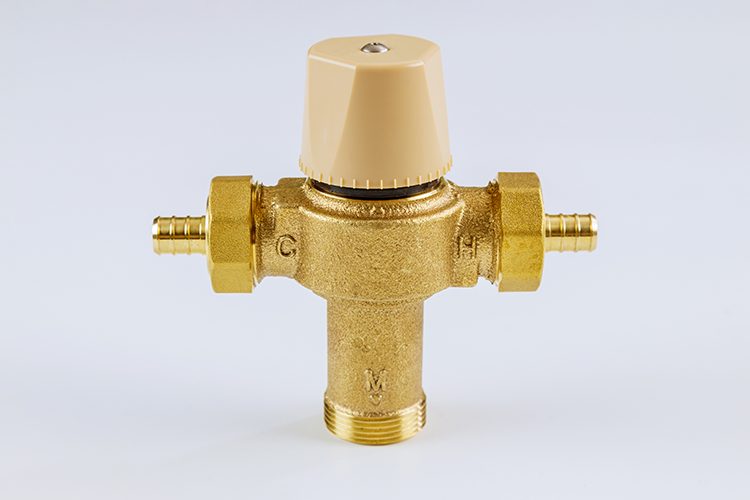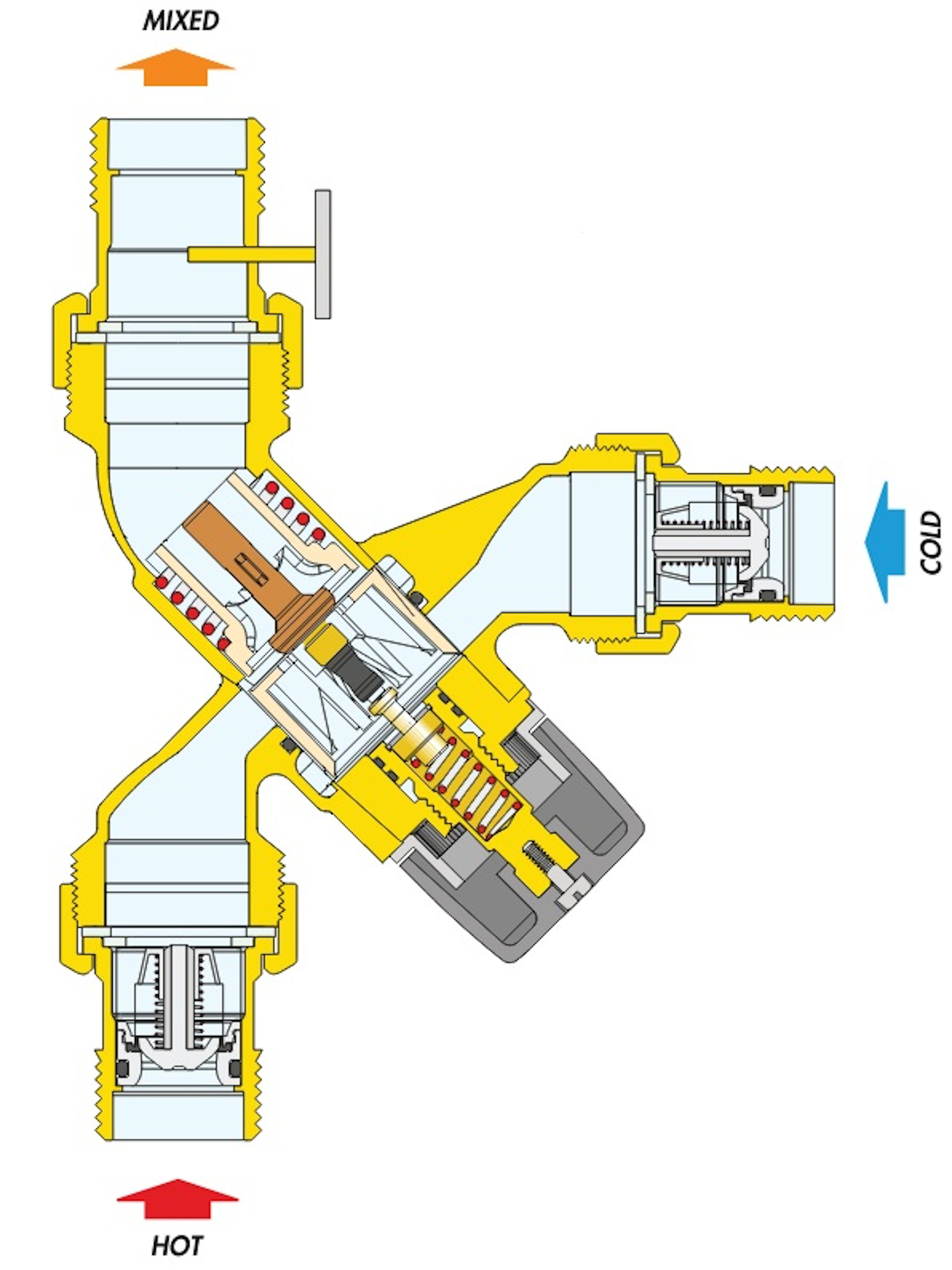Hydronics, DHW and Mixing Valves
Taking some of the mystery out of mixing valves.

It’s not uncommon for hydronics professionals to offer domestic hot water solutions to their customers. These options may include a cast-iron boiler with tankless coil, a combi boiler, a boiler with indirect, or even a plain old storage tank-style water heater. No matter the water heating application, there’s a good chance you’ve had your fair share of run-ins with three-way mixing valves.
These valves are supposed to take hot water, mix in a bit of cold water and give you the right temperature for your fixtures (see Figure 1). Seems simple, but there are a number of reasons why they may not be cooperative in your endeavors. So, why do we need them? What can we do to make sure they work as intended?

Why you’re using a mixing valve may boil down to codes in your area. Some areas require mixing valves on any DHW source. Others may only require them for commercial applications. Often, they’re used in efforts to manage Legionella bacteria. Storing water at higher temperatures will help, but you can’t have 140-degree water coming out of faucets and not expect phone calls from an attorney.
Sometimes, you’ll use them to extend the capacity of a water heater. In this case, you can store your water at higher temperatures and mix it down to a safe temperature using a mixing valve. This allows you to store more heat in your tank, making it go a little further for the poor, unfortunate person who is last to take a shower.
Another reason may be in the water heater manual. If you take the time to read it, you’ll see that many water heater manufacturers recommend mixing valves. Why? It’s not because they’re building a sub-par product. From my experience, it’s usually because of the controls’ limitations.
Start with Sizing
As you look at most water heaters, you’ll find a thermostat, control valve or aquastat somewhere on it. The problem is that this control can only know what temperature the water is at where it is located! It can’t consider temperature stacking or stratification.
It also has its limitations when it comes to differentials. You’ll find many aquastats with differentials of up to 10 degrees or more. All this means that the heater’s water can vary quite a bit in temperature.
When installed and set up properly, a three-way mixing valve can provide a consistent, safe temperature to your customers’ fixtures. However, when not installed or set up properly, a mixing valve may not produce the results you’re striving for. In many scenarios, this may look like a bad mixing valve, but you don’t blame your car for not moving because you didn’t put gas in it, do you?
When it comes to making sure mixing valves work as intended, the first place to start is sizing. Sizing a mixing valve requires an understanding of the building, its occupants and the peak demand they could put on the DHW system. Finding this peak flow rate is based on the probability of multiple fixtures being on at once. It will vary greatly based on building type, as an office building and a restaurant have very different requirements.
To help with sizing, you can look at your plumbing code, Hunter’s curve or even the IAPMO Water Demand Calculator (my personal favorite). It should be noted that most plumbing codes and even Hunter’s curve tend to greatly oversize your systems. All this is to say that you need to start somewhere, and when it comes to sizing mix valves, peak flow rate is where you must start.
You need to understand that the flow through the mixing valve will create a pressure drop. What is an acceptable pressure drop? From my travels, most engineers and designers will size a mix valve based on anywhere from a 5 to 15 pounds/square inch (psi) drop at peak flow rates.
Remember, peak flow rates are a lot like design days in heating and cooling systems: You may think that sizing at a lower pressure drop is great, but you should also realize that the system will rarely see those kinds of flows, thus leading to an oversized mixing valve.
With the peak flow rate and acceptable pressure drop, you can pick out a mixing valve. Be mindful of how valves are advertised: It may be noted that a valve is capable of 70 gallons/minute (gpm), but when you look a little further down the page, this flow rate is at a 50 psi pressure drop. While it’s true you can force-feed 70 gpm through the valve, no designer in their right mind will think a 50 psi pressure drop is acceptable.
Recirculation Systems
In all honesty, it’s quite rare (buy a lottery ticket) to see a mixing valve undersized. In the field, valves are often sized by pipe size with no regard to actual loads, leading to oversizing. Believe me, when it comes to mixing valves, oversizing is far worse than undersizing. Bigger is not better. Not only are you paying more for a valve you don’t need, but you’ll also likely get undesirable results from your mixing valve.
Unstable outlet temperatures, lack of control, etc., all lead to unhappy customers.
So, why does an oversized mix valve lead to unstable outlet temperatures? In my experience, the most common reason is you’re not meeting minimum flow requirements. While everyone is worried about the maximum flow rate of a system, little attention is paid to this very important detail.
This is exactly why bigger is not better. All mixing valves have a minimum flow rate; however, as the valves get bigger, so does the minimum flow requirement. When not met, you won’t get a turbulent mixture in the valve body; instead, the thermostatic element or sensor will see all hot or all cold, the valve will hunt, and your phone will ring.
Small, undersink mix valves may only require 0.35 gpm, which is usually no problem. On the other hand, you could have a 2-inch mixing valve requiring almost 9 gpm. In the case of the 2 inches, there’s almost no way to guarantee you’re meeting minimum flow rates with demand alone.
This is where DHW recirculation can come in and save the day. If properly sized and piped, the recirculation system can keep mixing valves very stable and building occupants very happy (see Figure 2).

For technicians: Before condemning a hunting valve, I recommend turning off and isolating any recirculation systems. Open enough fixtures to meet or exceed the minimum flow requirements of the mixing valve and see what happens. If the mixing valve gives you stable outlet temperatures, you can rule out the mixing valve and start looking at the recirculation system or associated piping.
In a future article, we’ll discuss the recirculation system and piping and how they can affect mixing valves and your customer’s satisfaction.





